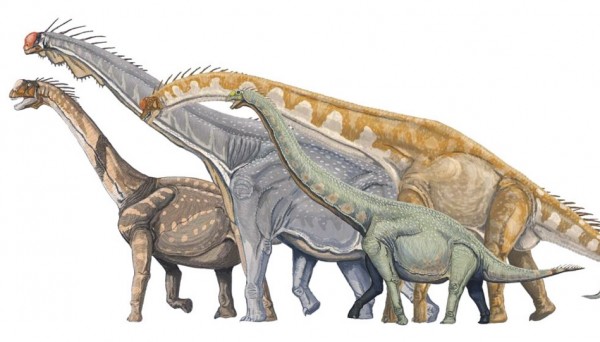Rare, Massive Dinosaur Footprints Discovered in Scotland
| Ana Verayo | | Dec 02, 2015 09:10 AM EST |
(Photo : Wikimedia) Several macronarian sauropods; from left to right, Camarasaurus, Brachiosaurus, Giraffatitan, and Euhelopus.
Scientists were able to uncover a collection of fascinating dinosaur footprints in Scotland that could reveal crucial information about the living environment and behaviors of these ancient colossal creatures.
This particular period called the Middle Jurassic is also teeming with rich evolutionary changes, however, scientists find it challenging to obtain data and evidence such as fossils from this time, throughout the planet. The most common evidence from this era are usually sparse numbers of teeth and bone fragments.
Like Us on Facebook
Now, scientists have discovered the largest dinosaur fossil site in the Isle of Skye, containing footprints and handprints originating from Middle Jurassic, measuring up to 28 inches in diameter.
According to lead author of the study Steve Brusatte of the University of Edinburgh, this is one of the most amazing Jurassic discoveries in the world.
These dino footprints apparently belong to sauropods which are plant eating dinosaurs that lived some 170 million years ago. Sauropods also have long necks and tails where these dinosaurs are recognized for their colossal size.
Brusatte says that the sauropods that once lived in the Isle of Skye have not been classified yet, but they are estimated to stand 50 feet tall and weighed 15 to 20 tons. Researchers then examined and analyzed these footprints, revealing that these sauropods are also close cousins of the famous brontosaurus and the diplodocus genus.
Prior research about sauropods suggested how these creatures used to dwell in swamplands since their massive size cannot be supported on land. This theory as debunked in the 1970s when scientists figured out that this species are well adapted to land, from fossilized skeletal evidence.
This new data from Scotland also suggests that these sauropods spent some considerable, significant amount of time underwater even if they are not considered as swimmers or sole water inhabitants.
Scientists are still trying to determine why these sauropods lived in the water however Brusatte says that the lagoon is also considered to be a good source of food or could even serve as protection for the species. This new study is published in the Scottish Journal of Geology.
Tagsdinosaur footprints, dinosaur disco footprints, dinosaur footprints scotland, sauropods, dinosaur footprints isle of skye, middle jurassic era, Dinosaurs, Scotland, isle of skye
©2015 Chinatopix All rights reserved. Do not reproduce without permission
EDITOR'S PICKS
-

Did the Trump administration just announce plans for a trade war with ‘hostile’ China and Russia?
-

US Senate passes Taiwan travel bill slammed by China
-

As Yan Sihong’s family grieves, here are other Chinese students who went missing abroad. Some have never been found
-

Beijing blasts Western critics who ‘smear China’ with the term sharp power
-

China Envoy Seeks to Defuse Tensions With U.S. as a Trade War Brews
-

Singapore's Deputy PM Provides Bitcoin Vote of Confidence Amid China's Blanket Bans
-

China warns investors over risks in overseas virtual currency trading
-

Chinese government most trustworthy: survey
-

Kashima Antlers On Course For Back-To-Back Titles
MOST POPULAR
LATEST NEWS
Zhou Yongkang: China's Former Security Chief Sentenced to Life in Prison

China's former Chief of the Ministry of Public Security, Zhou Yongkang, has been given a life sentence after he was found guilty of abusing his office, bribery and deliberately ... Full Article
TRENDING STORY

China Pork Prices Expected to Stabilize As The Supplies Recover

Elephone P9000 Smartphone is now on Sale on Amazon India

There's a Big Chance Cliffhangers Won't Still Be Resolved When Grey's Anatomy Season 13 Returns

Supreme Court Ruled on Samsung vs Apple Dispute for Patent Infringement

Microsoft Surface Pro 5 Rumors and Release Date: What is the Latest?










